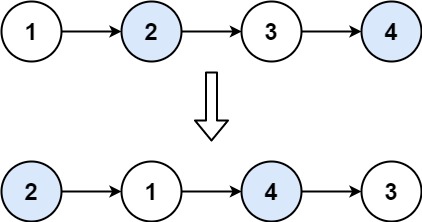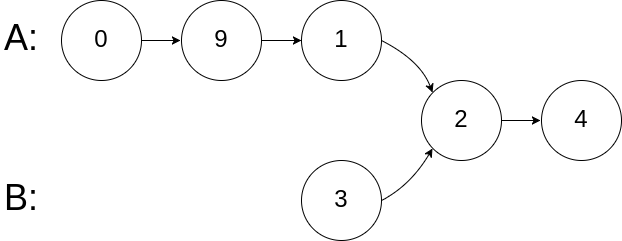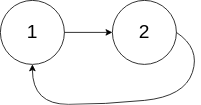203.移除链表元素
题目:
给你一个链表的头节点 head 和一个整数 val ,请你删除链表中所有满足 Node.val == val 的节点,并返回 新的头节点 。
示例 1:

1
2
| 输入:head = [1,2,6,3,4,5,6], val = 6
输出:[1,2,3,4,5]
|
示例 2:
1
2
| 输入:head = [], val = 1
输出:[]
|
示例 3:
1
2
| 输入:head = [7,7,7,7], val = 7
输出:[]
|
提示:
- 列表中的节点数目在范围
[0, 104] 内 1 <= Node.val <= 500 <= val <= 50
代码:
(不使用虚拟头结点)
1
2
3
4
5
6
7
8
9
10
11
12
13
14
15
16
17
18
| class Solution {
public ListNode removeElements(ListNode head, int val) {
while(head != null && head.val == val){
head = head.next;
}
ListNode cur = head;
while(cur != null && cur.next != null){
if(cur.next.val == val){
cur.next = cur.next.next;
}else{
cur = cur.next;
}
}
return head;
}
}
|
(使用虚拟头结点,一个指针)
1
2
3
4
5
6
7
8
9
10
11
12
13
14
| class Solution {
public ListNode removeElements(ListNode head, int val) {
ListNode dummy = new ListNode(-1,head);
ListNode cur = dummy;
while(cur.next != null){
if(cur.next.val == val){
cur.next = cur.next.next;
}else{
cur = cur.next;
}
}
return dummy.next;
}
}
|
(使用虚拟头结点,两个指针)
1
2
3
4
5
6
7
8
9
10
11
12
13
14
15
16
17
18
| class Solution {
public ListNode removeElements(ListNode head, int val) {
ListNode dummy = new ListNode(-1,head);
ListNode pre = dummy;
ListNode cur = head;
while(cur != null){
if(cur.val == val){
pre.next = cur.next;
cur = cur.next;
}else{
pre = pre.next;
cur = cur.next;
}
}
return dummy.next;
}
}
|
707.设计链表
题目:
你可以选择使用单链表或者双链表,设计并实现自己的链表。
单链表中的节点应该具备两个属性:val 和 next 。val 是当前节点的值,next 是指向下一个节点的指针/引用。
如果是双向链表,则还需要属性 prev 以指示链表中的上一个节点。假设链表中的所有节点下标从 0 开始。
实现 MyLinkedList 类:
MyLinkedList() 初始化 MyLinkedList 对象。int get(int index) 获取链表中下标为 index 的节点的值。如果下标无效,则返回 -1 。void addAtHead(int val) 将一个值为 val 的节点插入到链表中第一个元素之前。在插入完成后,新节点会成为链表的第一个节点。void addAtTail(int val) 将一个值为 val 的节点追加到链表中作为链表的最后一个元素。void addAtIndex(int index, int val) 将一个值为 val 的节点插入到链表中下标为 index 的节点之前。如果 index 等于链表的长度,那么该节点会被追加到链表的末尾。如果 index 比长度更大,该节点将 不会插入 到链表中。void deleteAtIndex(int index) 如果下标有效,则删除链表中下标为 index 的节点。
示例 :
1
2
3
4
5
6
7
8
9
10
11
12
13
14
| 输入
["MyLinkedList", "addAtHead", "addAtTail", "addAtIndex", "get", "deleteAtIndex", "get"]
[[], [1], [3], [1, 2], [1], [1], [1]]
输出
[null, null, null, null, 2, null, 3]
解释
MyLinkedList myLinkedList = new MyLinkedList();
myLinkedList.addAtHead(1);
myLinkedList.addAtTail(3);
myLinkedList.addAtIndex(1, 2); // 链表变为 1->2->3
myLinkedList.get(1); // 返回 2
myLinkedList.deleteAtIndex(1); // 现在,链表变为 1->3
myLinkedList.get(1); // 返回 3
|
提示:
0 <= index, val <= 1000- 请不要使用内置的 LinkedList 库。
- 调用
get、addAtHead、addAtTail、addAtIndex 和 deleteAtIndex 的次数不超过 2000 。
代码:
(单链表)
1
2
3
4
5
6
7
8
9
10
11
12
13
14
15
16
17
18
19
20
21
22
23
24
25
26
27
28
29
30
31
32
33
34
35
36
37
38
39
40
41
42
43
44
45
46
47
48
49
50
51
52
53
54
55
56
57
58
59
60
61
62
63
64
65
66
| public class ListNode{
int val;
ListNode next;
ListNode(){}
ListNode(int val){
this.val = val;
}
ListNode(int val,ListNode next){
this.val = val;
this.next = next;
}
}
class MyLinkedList {
int size;
ListNode dummy;
public MyLinkedList() {
this.size = 0;
this.dummy = new ListNode(-1,null);
}
public int get(int index) {
if(index < 0 || index >= size){
return -1;
}
ListNode cur = dummy;
for(int i = 0;i < index;i ++){
cur = cur.next;
}
return cur.next.val;
}
public void addAtHead(int val) {
addAtIndex(0,val);
}
public void addAtTail(int val) {
addAtIndex(size,val);
}
public void addAtIndex(int index, int val) {
if(index > size){
return;
}
size ++;
ListNode newNode = new ListNode(val,null);
ListNode cur = dummy;
for(int i = 0;i < index;i ++){
cur = cur.next;
}
newNode.next = cur.next;
cur.next = newNode;
}
public void deleteAtIndex(int index) {
if(index < 0 || index >= size){
return;
}
size --;
ListNode cur = dummy;
for(int i = 0;i < index;i ++){
cur = cur.next;
}
cur.next = cur.next.next;
}
}
|
(双链表)
1
2
3
4
5
6
7
8
9
10
11
12
13
14
15
16
17
18
19
20
21
22
23
24
25
26
27
28
29
30
31
32
33
34
35
36
37
38
39
40
41
42
43
44
45
46
47
48
49
50
51
52
53
54
55
56
57
58
59
60
61
62
63
64
65
66
67
68
69
70
71
72
73
74
75
| public class ListNode{
int val;
ListNode next;
ListNode prev;
ListNode(){}
ListNode(int val){
this.val = val;
}
ListNode(int val,ListNode prev,ListNode next){
this.val = val;
this.prev = prev;
this.next = next;
}
}
class MyLinkedList {
int size;
ListNode dummyHead;
ListNode dummyTail;
public MyLinkedList() {
this.size = 0;
dummyHead = new ListNode(-1);
dummyTail = new ListNode(-1);
dummyHead.next = dummyTail;
dummyTail.prev = dummyHead;
}
public int get(int index) {
if(index < 0 || index >= size){
return -1;
}
ListNode cur = dummyHead;
for(int i = 0;i < index;i ++){
cur = cur.next;
}
return cur.next.val;
}
public void addAtHead(int val) {
addAtIndex(0,val);
}
public void addAtTail(int val) {
addAtIndex(size,val);
}
public void addAtIndex(int index, int val) {
if(index > size){
return;
}
size ++;
ListNode newNode = new ListNode(val,null,null);
ListNode cur = dummyHead;
for(int i = 0;i < index;i ++){
cur = cur.next;
}
newNode.next = cur.next;
newNode.prev = cur;
cur.next.prev = newNode;
cur.next = newNode;
}
public void deleteAtIndex(int index) {
if(index < 0 || index >= size){
return;
}
size --;
ListNode cur = dummyHead;
for(int i = 0;i < index;i ++){
cur = cur.next;
}
cur.next.next.prev = cur;
cur.next = cur.next.next;
}
}
|
206.反转链表
题目:
给你单链表的头节点 head ,请你反转链表,并返回反转后的链表。
示例 1:

1
2
| 输入:head = [1,2,3,4,5]
输出:[5,4,3,2,1]
|
示例 2:

1
2
| 输入:head = [1,2]
输出:[2,1]
|
示例 3:
提示:
- 链表中节点的数目范围是
[0, 5000] -5000 <= Node.val <= 5000
进阶:链表可以选用迭代或递归方式完成反转。你能否用两种方法解决这道题?
代码:
(双指针法)
1
2
3
4
5
6
7
8
9
10
11
12
13
| class Solution {
public ListNode reverseList(ListNode head) {
ListNode pre = null;
ListNode cur = head;
while(cur != null){
ListNode temp = cur.next;
cur.next = pre;
pre = cur;
cur = temp;
}
return pre;
}
}
|
(递归法)
1
2
3
4
5
6
7
8
9
10
11
12
13
14
| class Solution {
public ListNode reverseList(ListNode head) {
return reverse(null,head);
}
public ListNode reverse(ListNode pre,ListNode cur){
if(cur == null){
return pre;
}
ListNode temp = cur.next;
cur.next = pre;
return reverse(cur,temp);
}
}
|
24. 两两交换链表中的节点
题目:
给你一个链表,两两交换其中相邻的节点,并返回交换后链表的头节点。你必须在不修改节点内部的值的情况下完成本题(即,只能进行节点交换)。
示例 1:

1
2
| 输入:head = [1,2,3,4]
输出:[2,1,4,3]
|
示例 2:
示例 3:
提示:
- 链表中节点的数目在范围
[0, 100] 内 0 <= Node.val <= 100
代码:
1
2
3
4
5
6
7
8
9
10
11
12
13
14
15
| class Solution {
public ListNode swapPairs(ListNode head) {
ListNode dummy = new ListNode(-1,head);
ListNode cur = dummy;
while(cur.next != null && cur.next.next != null){
ListNode temp1 = cur.next;
ListNode temp2 = cur.next.next.next;
cur.next = cur.next.next;
cur.next.next = temp1;
temp1.next = temp2;
cur = cur.next.next;
}
return dummy.next;
}
}
|
19.删除链表的倒数第N个节点
题目:
给你一个链表,删除链表的倒数第 n 个结点,并且返回链表的头结点。
示例 1:

1
2
| 输入:head = [1,2,3,4,5], n = 2
输出:[1,2,3,5]
|
示例 2:
1
2
| 输入:head = [1], n = 1
输出:[]
|
示例 3:
1
2
| 输入:head = [1,2], n = 1
输出:[1]
|
提示:
- 链表中结点的数目为
sz 1 <= sz <= 300 <= Node.val <= 1001 <= n <= sz
进阶:你能尝试使用一趟扫描实现吗?
代码:
1
2
3
4
5
6
7
8
9
10
11
12
13
14
15
16
| class Solution {
public ListNode removeNthFromEnd(ListNode head, int n) {
ListNode dummy = new ListNode(-1,head);
ListNode fast = dummy;
ListNode slow = dummy;
for(int i = 0;i <= n;i ++){
fast = fast.next;
}
while(fast != null){
fast = fast.next;
slow = slow.next;
}
slow.next = slow.next.next;
return dummy.next;
}
}
|
面试题 02.07. 链表相交
题目:
给你两个单链表的头节点 headA 和 headB ,请你找出并返回两个单链表相交的起始节点。如果两个链表没有交点,返回 null 。
图示两个链表在节点 c1 开始相交:

题目数据 保证 整个链式结构中不存在环。
注意,函数返回结果后,链表必须 保持其原始结构 。
示例 1:

1
2
3
4
5
| 输入:intersectVal = 8, listA = [4,1,8,4,5], listB = [5,0,1,8,4,5], skipA = 2, skipB = 3
输出:Intersected at '8'
解释:相交节点的值为 8 (注意,如果两个链表相交则不能为 0)。
从各自的表头开始算起,链表 A 为 [4,1,8,4,5],链表 B 为 [5,0,1,8,4,5]。
在 A 中,相交节点前有 2 个节点;在 B 中,相交节点前有 3 个节点。
|
示例 2:

1
2
3
4
5
| 输入:intersectVal = 2, listA = [0,9,1,2,4], listB = [3,2,4], skipA = 3, skipB = 1
输出:Intersected at '2'
解释:相交节点的值为 2 (注意,如果两个链表相交则不能为 0)。
从各自的表头开始算起,链表 A 为 [0,9,1,2,4],链表 B 为 [3,2,4]。
在 A 中,相交节点前有 3 个节点;在 B 中,相交节点前有 1 个节点。
|
示例 3:

1
2
3
4
5
| 输入:intersectVal = 0, listA = [2,6,4], listB = [1,5], skipA = 3, skipB = 2
输出:null
解释:从各自的表头开始算起,链表 A 为 [2,6,4],链表 B 为 [1,5]。
由于这两个链表不相交,所以 intersectVal 必须为 0,而 skipA 和 skipB 可以是任意值。
这两个链表不相交,因此返回 null 。
|
提示:
listA 中节点数目为 mlistB 中节点数目为 n0 <= m, n <= 3 * 1041 <= Node.val <= 1050 <= skipA <= m0 <= skipB <= n- 如果
listA 和 listB 没有交点,intersectVal 为 0 - 如果
listA 和 listB 有交点,intersectVal == listA[skipA + 1] == listB[skipB + 1]
进阶:你能否设计一个时间复杂度 O(n) 、仅用 O(1) 内存的解决方案?
代码:
(Hash表法)
1
2
3
4
5
6
7
8
9
10
11
12
13
14
15
16
17
18
| public class Solution {
public ListNode getIntersectionNode(ListNode headA, ListNode headB) {
Set<ListNode> set = new HashSet<>();
ListNode temp = headA;
while(temp != null){
set.add(temp);
temp = temp.next;
}
temp = headB;
while(temp != null){
if(set.contains(temp)){
return temp;
}
temp = temp.next;
}
return null;
}
}
|
(双指针法)
1
2
3
4
5
6
7
8
9
10
11
12
13
14
15
16
17
18
19
| public class Solution {
public ListNode getIntersectionNode(ListNode headA, ListNode headB) {
ListNode p1 = headA;
ListNode p2 = headB;
while(p1 != p2){
if(p1 == null){
p1 = headB;
}else{
p1 = p1.next;
}
if(p2 == null){
p2 = headA;
}else{
p2 = p2.next;
}
}
return p1;
}
}
|
(先行移动长链表实现同步移动)
1
2
3
4
5
6
7
8
9
10
11
12
13
14
15
16
17
18
19
20
21
22
23
24
25
26
27
28
29
30
31
32
33
34
35
36
37
38
39
40
41
| public class Solution {
public ListNode getIntersectionNode(ListNode headA, ListNode headB) {
int lenA = 0;
int lenB = 0;
ListNode temp = headA;
while(temp != null){
lenA ++;
temp = temp.next;
}
temp = headB;
while(temp != null){
lenB ++;
temp = temp.next;
}
ListNode curA = headA;
ListNode curB = headB;
if(lenB > lenA){
int temp1 = lenA;
lenA = lenB;
lenB = temp1;
ListNode tempNode = curA;
curA = curB;
curB = tempNode;
}
int gap = lenA - lenB;
while(gap -- > 0){
curA = curA.next;
}
while(curA != null){
if(curA == curB){
return curA;
}
curA = curA.next;
curB = curB.next;
}
return null;
}
}
|
142.环形链表II
题目:
给定一个链表的头节点 head ,返回链表开始入环的第一个节点。 如果链表无环,则返回 null。
如果链表中有某个节点,可以通过连续跟踪 next 指针再次到达,则链表中存在环。 为了表示给定链表中的环,评测系统内部使用整数 pos 来表示链表尾连接到链表中的位置(索引从 0 开始)。如果 pos 是 -1,则在该链表中没有环。注意:pos 不作为参数进行传递,仅仅是为了标识链表的实际情况。
不允许修改 链表。
示例 1:

1
2
3
| 输入:head = [3,2,0,-4], pos = 1
输出:返回索引为 1 的链表节点
解释:链表中有一个环,其尾部连接到第二个节点。
|
示例 2:

1
2
3
| 输入:head = [1,2], pos = 0
输出:返回索引为 0 的链表节点
解释:链表中有一个环,其尾部连接到第一个节点。
|
示例 3:

1
2
3
| 输入:head = [1], pos = -1
输出:返回 null
解释:链表中没有环。
|
提示:
- 链表中节点的数目范围在范围
[0, 104] 内 -105 <= Node.val <= 105pos 的值为 -1 或者链表中的一个有效索引
进阶:你是否可以使用 O(1) 空间解决此题?
代码:
1
2
3
4
5
6
7
8
9
10
11
12
13
14
15
16
17
18
19
20
| public class Solution {
public ListNode detectCycle(ListNode head) {
ListNode slow = head;
ListNode fast = head;
while(fast != null && fast.next != null){
slow = slow.next;
fast = fast.next.next;
if(slow == fast){
ListNode index1 = head;
ListNode index2 = slow;
while(index1 != index2){
index1 = index1.next;
index2 = index2.next;
}
return index1;
}
}
return null;
}
}
|













